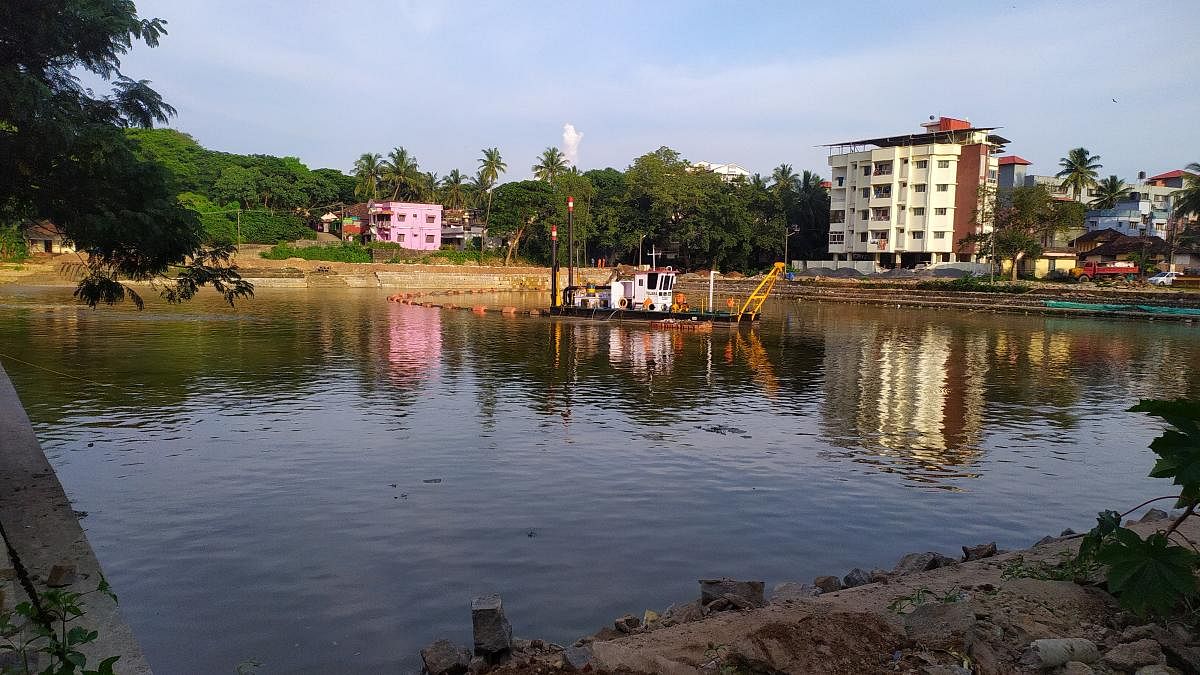
Gujjarakere, one of the important surface water bodies in Jeppu, will get a fresh lease of life under the Smart City Mission.
The waterbody, spread over an area of 3.4 acres, has a history of over 1,800 years, but, had remained ignored for several decades.
The Gujjarakere Theertha Samrakshana Samithi’s campaign on saving and rejuvenating the waterbody is now yielding a result, with the work being taken up under Mangaluru Smart City Mission.
Gujjarakere was a source of drinking water in the past and associated with the religious ceremonies of the nearby Mangaladevi Temple and Marigudi Temple.
During the Deepotsava of Mangaladevi Temple, the chariot passes near the lake and proceeds towards ‘Gujjarakere katte’, a pedestal near the lake where the procession idol of the presiding deity is worshipped.
As a part of the development work, the silt is being removed from the lake using a dredger. An amount of Rs 4 crore will be spent on the rejuvenation of Gujjarakere.
As a part of the work, after removing the silt, the work on retaining wall, steel railing, footpath, jogging track, stormwater drains, seating arrangements, lights and toilet complex will be taken up.
Stating that Gujjarakere will be developed into a model lake, Mangalore South MLA D Vedavyas Kamath says that the work on removing the silt is in progress. Silt will be removed from 15 feet deep in the lake.
Several old lakes in Mangaluru city have become extinct due to lack of maintenance. There is a need to maintain the existing lake into a source of drinking water supply for the citizens and pass it on to the future generation.
After removing the silt, Gujjarakere will be cleaned and measures will be taken to ensure that no sewage enters Gujjarakere. The landscape of the area will be beautified.
Nemu Kottari of Gujjarakere Theertha Samrakshana Samithi says, “The work on desilting the lake began 15 days ago. We want the water body to remain unpolluted and thereby help in improving the groundwater table in the vicinity. The rejuvenation of the water body will help in improving the ecology in the surrounding areas.”
The Samithi has been fighting for the cause of Gujjarakere since 2001. Owing to the failure to plug the sewage entering the kere, the lake was full of weeds.
The lake had turned into a dump yard with multiple drainage connections leading to it and had even become a breeding ground for mosquitoes.
All these years, the reviving work of the lake had gone down the drain as the sole purpose of the project had failed.
An amount of Rs 1.99 crore was spent by the Mangaluru City Corporation for the rejuvenation of the lake between 2008 and 2010. Again, Rs 25 lakh was used for the underground drainage system in the locality, in 2011.
In the year 2015, the Department of Minor Irrigation had released Rs 1 crore towards the desilting and dredging work.
In 2017, Rs 3 crore was released to plug the sewage entering the lake and to take up UGD work in the vicinity.
In spite of plugging the sewage entering the lake, coliform count and faecal coliform count in the water of Gujjarakere are above the permissible limits, according to a test conducted at Fisheries College in Mangaluru recently, says Nemu Kottari, adding that he has already brought it to the notice of the MLA.